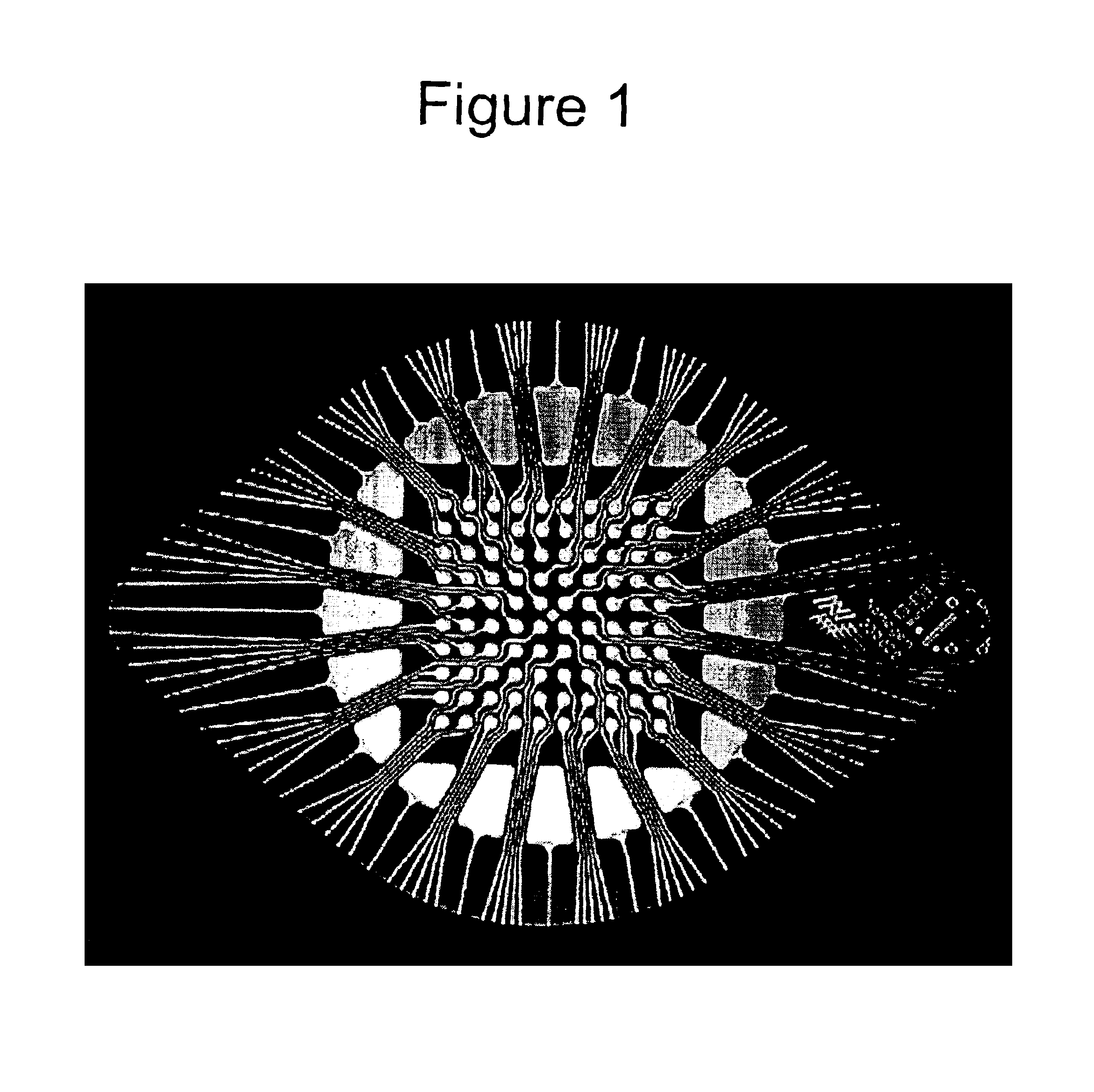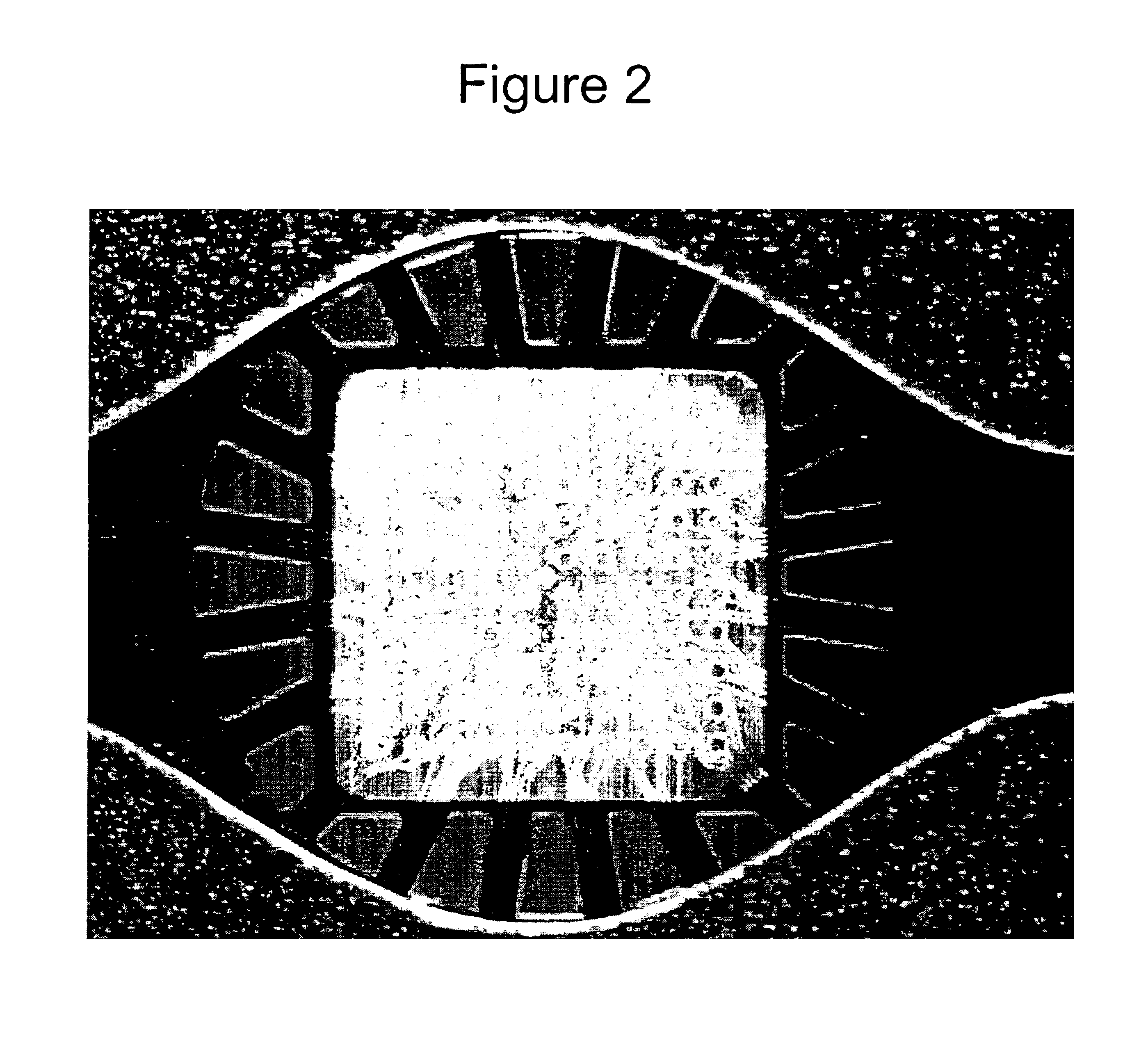Mesoporous permeation layers for use on active electronic matrix devices
a technology of electronic matrix and permeation layer, which is applied in the direction of gravity filter, osmosis/dialysis, filter regeneration, etc., can solve the problems of agarose as a permeation layer material, the permeation layer is prone to separate or ‘delaminate’ from the electrode interface, and the permeation layer is easy to be molded, etc., to achieve a high degree of uniformity, easy formation of a permeation layer
- Summary
- Abstract
- Description
- Claims
- Application Information
AI Technical Summary
Benefits of technology
Problems solved by technology
Method used
Image
Examples
example 1
Exemplary Mesoporous Synthetic Hydrogel Permeation Layers
A. Acryloyl or Acrylamido Streptavidin Production
[0146]For incorporation into the mesoporous synthetic hydrogel permeation layer formulations, functionalized streptavidin derivatives with pendant acryl groups for incorporation into the polymer backbone were prepared. Streptavidin was derivatized with either an acrylamido group, or an amide-linked PEG 3400-ester-acryloyl group, according to the reaction scheme in FIG. 3. A N-acryloxysuccinimide was from Polysciences, Inc. and was used as received. α-Acryloyl, ω-N-hydroxysuccinimidyl ester of poly(ethylene glycol)—propionic acid, (M.W. 3400) (PEG-NHS) was from Shearwater Polymers, Inc. Streptavidin (SA) was purchased from Roche Molecular Biochemicals.
[0147]Native SA (165 mg) and an excess of NHS reagent (2.4 mg) were weighed out into a 15-ml disposable polypropylene cell culture tube. Sodium phosphate buffer (50 mM, pH 9, 12 ml) was added and the tube was vortexed briefly until ...
example 2
Scanning Electron Microscopy of the Mesoporous Synthetic Polymer Hydrogel Permeation Layer Structure
[0165]The morphology of the mesoporous synthetic polymer hydrogel permeation layers was examined using a scanning electron microscope (SEM). Samples for SEM were prepared by gradual exchange of the water for ethanol in a gradient mode and subsequent drying by critical point drying technique with supercritical CO2. This procedure has been reported to maintain the gel structure of the polymer with very little alteration. The scanning electron micrographs are shown in FIGS. 5A & B (4012-1), 6A & B (40012-2), 7A & B (4012-3), and 8A & B (4006-1). These micrographs clearly show the microstructure of the gels in the 5,000× scan, and show the mesostructure of the gels in the 45,000× scan. From these pictures, the physically heterogeneous nature of the mesoporous synthetic polymer hydrogel permeation layers is evident, especially when compared to the relatively physically homogeneous nature o...
example 3
Use of θ to Quantify the Porosity of Mesoporous Synthetic Polymer Hydrogel Permeation Layers
[0172]As is shown by the scanning electron micrographs, the porosity of synthetic polymer hydrogels can be varied by varying the amount of template porogen, such as Brij surfactant, used in the polymerization mixture. Although the SEM micrographs are useful to qualitatively and quantitatively evaluate the morphology of the mesoporous synthetic polymer hydrogel permeation layers, a less labor intensive quantitative porosity measurement was desired. Towards that end, dark field microscopy was used to quantify the morphological changes due to phase separation.
[0173]A dimensionless parameter, θ (theta), was used to express the degree of phase separation, or porosity, based on light scattering measurements under the dark field microscope. The dimensionless degree of phase separation (θ) was determined by integrating the dark filed light intensity readings a dry hydrogel layer on the test chip (λ),...
PUM
| Property | Measurement | Unit |
|---|---|---|
| thick | aaaaa | aaaaa |
| thick | aaaaa | aaaaa |
| thick | aaaaa | aaaaa |
Abstract
Description
Claims
Application Information
 Login to View More
Login to View More - R&D
- Intellectual Property
- Life Sciences
- Materials
- Tech Scout
- Unparalleled Data Quality
- Higher Quality Content
- 60% Fewer Hallucinations
Browse by: Latest US Patents, China's latest patents, Technical Efficacy Thesaurus, Application Domain, Technology Topic, Popular Technical Reports.
© 2025 PatSnap. All rights reserved.Legal|Privacy policy|Modern Slavery Act Transparency Statement|Sitemap|About US| Contact US: help@patsnap.com



